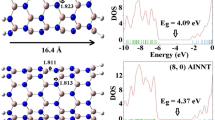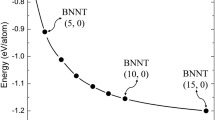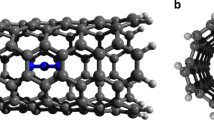Abstract
We have systematically investigated the noncovalent and covalent adsorption of alanine and alanine radicals, respectively, onto a (5, 0) single-walled carbon nanotube using first-principles calculation. It was found that XH···π (X = N, O, C) interactions play a crucial role in the non-ovalent adsorption and that the functional group close to the carbon nanotube exhibits a significant influence on the binding strength. Noncovalent functionalization of the carbon nanotube with alanine enhances the conductivity of the metallic (5, 0) nanotube. In the covalent adsorption of each alanine radical onto a carbon nanotube, the binding energy depends on the adsorption site on CNT and the electronegative atom that binds with the CNT. The strongest complex is formed when the alanine radical interacts with a (5, 0) carbon nanotube through the amine group. In some cases, the covalent interaction of the alanine radical introduces a half-filled band at the Fermi level due to the local sp 3 hybridization, which modifies the conductivity of the tube.









Similar content being viewed by others
References
Bradley K, Briman M, Star A, Gruner G (2004) Charge transfer from adsorbed proteins. Nano Lett 4:253–256
Kuang Z, Kim SN, Crookes-Goodson WJ, Farmer BL, Naik RR (2010) Biomimetic chemosensor: designing peptide recognition elements for surface functionalization of carbon nanotube field effect transistors. ACS Nano 4:452–458
Azamian BR, Davis JJ, Coleman KS, Bagshaw CB, Green MLH (2002) Bioelectrochemical single-walled carbon nanotubes. J Am Chem Soc 124:12664–12665
Vardanega D, Picaud F, Girarder C (2007) Chiral response of single walled carbon nanotube based sensors to adsorption of amino acids: a theoretical model. J Chem Phys 127:194702–194712
Mora MF, Giacomelli CE, Garcia CD (2009) Interaction of L-amino acid oxidase with carbon nanotubes: implications in the design of biosensors. Anal Chem 81:1016–1022
Abadir GB, Walus K, Pulfrey DL (2010) Bias-dependent amino-acid-induced conductance changes in short semi-metallic carbon nanotubes. Nanotechnolgy 21:015202–015208
Robinson JT, Welsher K, Tabakman SM, Sherlock SP, Wang H, Luong R, Dai H (2010) High performance in vivo near-IR (>1 μm) imaging and photothermal cancer therapy with carbon nanotubes. Nano Res 3:779–793
McCarroll J, Baigude H, Yang C, Rana TM (2010) Nanotubes functionalized with lipids and natural amino acid dendrimers: a new strategy to create nanomaterials for delivering systemic RNAi. Bioconjug Chem 21:56–63
Lu Q, Moore JM, Huang G, Mount AS, Rao AM (2004) RNA polymer translocation with single-walled carbon nanotubes. Nano Lett 4:2473–2477
Lee HJ, Park J, Yoon OJ, Kim HW, Lee DY, Kim DH, Lee WB, Lee NE, Boventre JV, Kim SS (2011) Amine-modified single-walled carbon nanotubes protect neurons from injury in a rat stroke model. Nat Nanotechnol 6:121–125
Kam NWS, Lui Z, Dai H (2005) Nanotubes as intracellular transporters for proteins and DNA: an investigation of the uptake mechanism and pathway. Angew Chem Int Ed 44:1–6
Zorbas V, Smith AL, Xie H, Ortiz-Acevedo A, Dalton AB, Doeckmann GR, Draper RK, Baughman RH, Musselman IH (2005) Importance of aromatic content of peptide/single-walled carbon nanotube interactions. J Am Chem Soc 127:12323–12382
Witus LS, Rocha JDR, Yumono VM, Paramonov SE, Weisman RB, Hartgerink JD (2007) Peptides that non-covalently functionalize single-walled carbon nanotubes to give controlled solubility characteristics. J Mater Chem 17:1909–1915
Fan W, Zeng J, Zhang R (2009) Quantum mechanical quantification of weakly interacting complexes of peptides with single-walled carbon nanotubes. J Chem Theor Comput 5:2879–2885
Wang Y, Ai H (2009) Theoretical insights into the interaction mechanism between proteins and SWCNTs: adsorptions of tripeptides GXG on SWCNTs. J Phys Chem B 113:9620–9627
Roman T, Dino WA, Nakanishi H, Kasai H (2006) Amino acid adsorption on single-walled carbon nanotubes. Eur Phys J D38:117–120
Ganji MD (2009) Density functional theory based treatment of amino acids adsorption on single-walled carbon nanotubes. Diamond Relat Mater 18:662–668
Sun W, Bu Y, Wang Y (2008) Interaction between glycine/glycine radicals and intrinsic/boron-doped (8, 0) single-walled carbon nanotubes: a density functional theory study. J Phys Chem B 112:15442–15449
De Leon A, Jalbout AF, Basiuk VA (2008) SWNT–amino acid interactions: a theoretical study. Chem Phys Lett 457:185–190
Chang CM, Jalbout AF (2010) Metal induced amino acid adsorption on nanotubes. Thin Solid Films 518:2070–2076
Rajesh C, Majumder C, Mizuseki H, Kawazoe Y (2009) A theoretical study on the interaction of aromatic amino acids with graphene and single walled carbon nanotube. J Chem Phys 130:124911–124916
Bianco A, Kostaredes K, Partidos CD, Prato M (2005) Biomedical applications of functionalized carbon nanotubes. Chem Commun 571–577
Zhang Y, Li J, Shen Y, Wang M, Li J (2004) Poly-L-lysine functionalization of single-walled carbon nanotube. J Phys Chem B 108:15343–15346
Pulikkathara MX, Khabasheska VN (2008) Covalent sidewall functionalization of single-walled carbon nanotubes by aminoacids. Russ Chem Bull Int Edn 57:1054–1062
Carneiro MA, Venezuela P (2008) First principles calculations of alanine radicals adsorbed on pristine and functionalized carbon nanotubes. J Phys Chem C 112:14812–14815
Kresse G, Furthmuller J (1996a) Efficient iterative schemes for ab initio total-energy calculations using a plane-wave basis set. Phys Rev B 54:11169–11186
Kresse G, Furthmuller J (1996b) Efficiency of ab-initio total energy calculations for metals and semiconductors using a plane-wave basis set. Comput Mater Sci 6:15–50
Blochl PE (1994a) Projector augmented-wave method. Phys Rev B 50:17953–17979
Kresse G, Joubert D (1999) From ultrasoft pseudopotentials to the projector augmented-wave method. Phys Rev B 59:1758–1775
Perdew JP, Zunger A (1981) Self-interaction correction to density-functional approximations for many-electron systems. Phys Rev B 23:5048–5079
Perdew JP, Chevary JA, Vosko SH, Jackson KA, Pederson MR, Singh DJ, Fiolhais C (1992) Atoms, molecules, solids, and surfaces: applications of the generalized gradient approximation for exchange and correlation. Phys Rev B 46:6671–6687
Ortmann F, Schmidt WG, Bechstedt F (2005) Attracted by long range electron correlation: adenine and graphite. Phys Rev Lett 95:186101–186104
Lim S, Park N (2009) Ab initio study of noncovalent sidewall functionalization of carbon nanotubes. Appl Phys Lett 95:243110–243113
Tournus F, Latil S, Heggie MI, Charlier JC (2005) π-Stacking interaction between carbon nanotubes and organic molecules. Phys Rev B 72:075431–075435
Simeonia M, De Luca C, Picozzi S, Santucci S, Delley B (2005) Interaction between zigzag single-wall carbon nanotubes and polymers: a density-functional study. J Chem Phys 122:214710–214718
Monkhorst HJ, Pack JD (1976) Special points for Brillouin-zone integrations. Phys Rev B 13:5188–5192
Henkelman G, Arnaldsson A, Jonsson H (2006) A fast and robust algorithm for Bader decomposition of charge density. Comput Mater Sci 36:254–360
Kokalj A (2005) Computer graphics and graphical user interfaces as tools in simulations of matter at the atomic scale. Comput Mater Sci 28:155–168
Gulseren O, Yildirim T, Ciraci S (2002) Systematic ab initio study of curvature effects in carbon nanotubes. Phys Rev B 65:153405–4
Iyakutti K, Bodapati A, Peng X, Keblinsi P, Nayak SK (2006) Electronic band structure, electron–phonon interaction, and superconductivity of (5, 5), (10, 10), and (5, 0) carbon nanotubes. Phys Rev B 73:35413–35415
Zhao J, Park H, Han J, Lu JP (2004) Electronic properties of carbon nanotubes with covalent sidewall functionalization. J Phys Chem B 108:4227–4230
Mohan N, Vijayalakshmi KP, Koga N, Suresh CH (2010) Comparison of aromatic NH–π, OH–π and CH–π interactions of alanine using MP2, CCSD and DFT methods. J Comput Chem 16:2874–2882
Acknowledgments
The University Grants Commission of India is acknowledged for assisting this project with a junior research fellowship, provided under the University with Potential for Excellence scheme. One of the authors, K.I., acknowledges the financial support provided by the Council of Scientific and Industrial Research under the Emeritus Scientist scheme. The authors would like to express their sincere thanks to the staff of the Centre for Computational Materials Science at the Institute for Materials Research, Tohoku University, for their continuous support in relation to the SR11000 supercomputing facilities.
Author information
Authors and Affiliations
Corresponding author
Rights and permissions
About this article
Cite this article
Rajarajeswari, M., Iyakutti, K. & Kawazoe, Y. Noncovalent and covalent functionalization of a (5, 0) single-walled carbon nanotube with alanine and alanine radicals. J Mol Model 18, 771–781 (2012). https://doi.org/10.1007/s00894-011-1115-3
Received:
Accepted:
Published:
Issue Date:
DOI: https://doi.org/10.1007/s00894-011-1115-3




